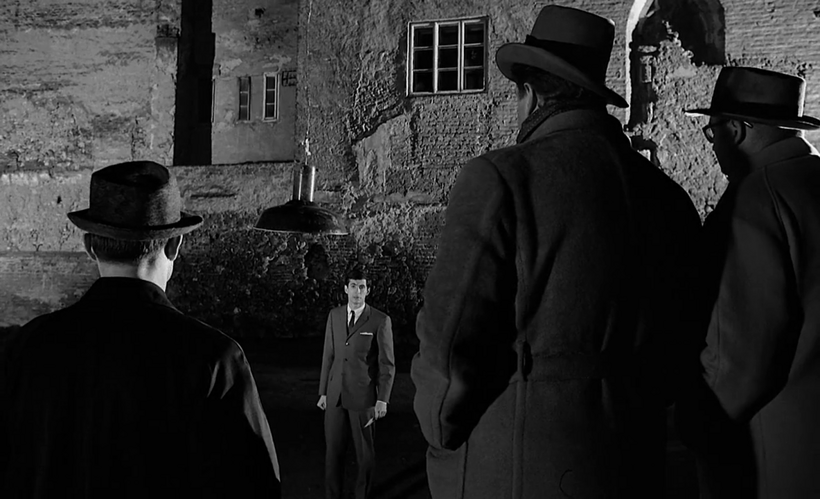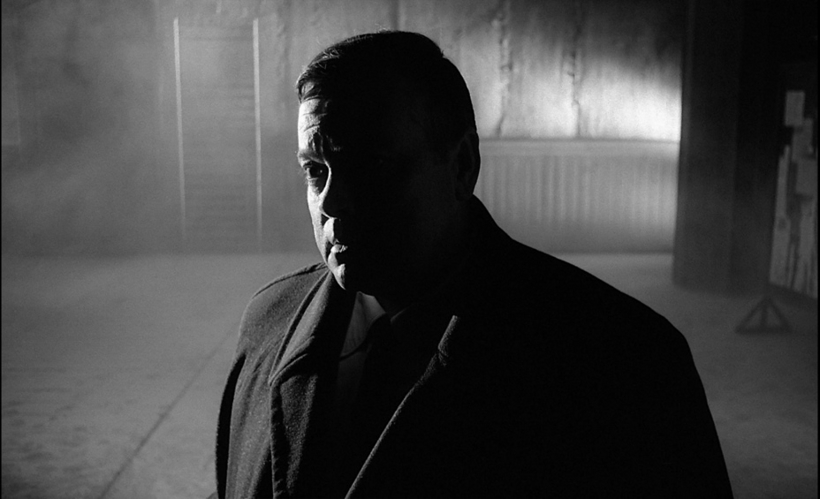Who better to take on “Kafkaesque” than the Wisconsin wunderkind?
Interest in modernist author Franz Kafka continues to peak a hundred years after The Trial‘s conception (and 90 years after its publication in 1925), and over a half-century in the cinema medium with the most recent Mongolian interpretation of Kafka’s final novel, The Castle, simply entitled K., finding its premiere in 2015. However, the audacious Orson Welles took the first leap to bring Kafka’s text to the big screen in 1962 with an adaptation of his most celebrated and influential novella that was primarily filmed in an abandoned Belle Époque railway station in Paris. Significance of The Trial to twentieth century literature (and our evermore abstract condition) has taken on an uncanny life of its own, and its mystique is harnessed in the late Welles’ reapplying of recognizable noir in a surrealist context that concerns a financial officer named Josef K. (Anthony Perkins), whose home is pried open by a pair of shadowy, interminably inquisitive inspectors. The men do not reveal their agency, nor the crime for which K. is presumed guilty, nor his accuser.
What follows is a labyrinthine tale of impenetrable confusion and inaccessibility to the legal system, which Welles starkly sets up in his unmistakably magisterial baritone voiceover. Welles’ voice lumbers over the film’s opening “pin screen” parable visually represented in a series of Egyptian-like illustrations by Alexandre Alexeieff and Claire Parker. Who better, then, to take on this material than the Wisconsin wunderkind, who consistently contested the Hollywood system’s censorship since his ascent in the 1940s? The Trial [Le procès] remains such a relevant and intriguing work in the age of technological oppression and surveillance, because, in John Updike’s discerning words, Kafka draws us nearer to “a sensation of anxiety and shame whose center cannot be located and thus cannot be placated, a sense of infinite difficulty within things impeding every step, a sensitivity acute beyond usefulness as if the nervous system… must record every touch as pain.”
Perkins, fresh off his iconic, career-defining role as the identity dissociative Norman Bates in Psycho (1960), turns in a naif performance as the stupefied protagonist, whom he initially plays as more of a demure and bumbling high-schooler than the obstinately helpless cog in the machine of the source text. While the discrepancy might be a bit jarring to the Kafka faithful, the interpretation is not altogether discredited through its association to the relentlessly self-critical author’s protagonists as thinly veiled surrogates for himself (Kafka eventually succumbed to his own inexplicable hauntings of fear and guilt like K. in The Trial.) And despite Welles’ typically self-possessed and imposing on-screen persona, which he utilizes in an unforgettable role as K.’s lawyer, Advocate Hastler, he is remarkably attuned to the Paranoid’s dilemma in all phases of production. Given total creative control by producer Alexander Salkind, Welles operates as the auteur, opposite the lone soul of K., for the first time since his universally acclaimed Citizen Kane (1941).
Welles rephrases most literal English translations of German dialogue (most famously by the Muirs, Willa and Edwin) to reduce stiltedness but retain the distinctive nightmarish legal conspiracy spiraling outward from its central character as if he were a gnat struggling in a spider’s web (with incidental allusions to The Metamorphosis.) Naturalism is therefore avoided in cinematography, editing rhythm, and sound design as well; most indicative is the copious use of diagonal lines, particularly in architecture, long shots sharply juxtaposed with extreme close-ups, and low oblique angles that contribute to the increasing psychological imbalance and formidable forces of the law. These modus operandi cross paths at the film’s most ingeniously edited sequence of archetypal dream logic, as Welles omnipotently explains at the close of the prologue, where a flushed K. flees court painter Titorelli (William Chappell)’s loft only to immediately emerge in the law offices before bearing down into a Third Man-esque maze of tunnels. Jean Ledrut’s loose orchestral, jazz, and organ score also waltzes in-and-out-of-step with K.’s trials. The music alludes to cinematic sources of influence that include an amalgamation of Hollywood and European noirs, from the lithe bassline that defines K.’s worldly night owl neighbor Fraülein Bürstner (Jeanne Moreau) to the plodding organ lurking beneath the surface, intermittently resonating, subliminally coaxing K. towards the cathedral in the final minutes.
What makes the film as much of a magnetizing experience as the novella is Welles’ ability to craft a schizophrenic space that is personified as a whole, shifting shape and dimension as if K. is slowly being devoured in an environmental mesh of the art of M.C. Escher and Salvador Dali. No doubt it served as an inspiration to the stylized cinematography of Polanski’s Repulsion (1965) a few years down the tortuous path and Gilliam’s Brazil (1985) two decades later. The increasingly macabre imagery and starker contrasts of light and dark are further legitimized in the lunacy of the conclusion, which departs from Kafka’s original, yet accurately reflects the vision of its director and the desperation in K.’s irremediable situation. Welles manages to capture the delusional tone of the text that has endured for a century, uniting the conundrums of a psychological thriller and caustic black comedy. Afterwards, in a self-therapeutic gesture, curl up with a copy of Scott Stossel’s memoir, My Age of Anxiety: Fear, Hope, Dread, and the Search for Peace of Mind.
- The Trial screens on Friday, Sept 11, at 7:00p as part of Cinematheque’s Centennial Celebration of Orson Welles, Part IV at 4070 Vilas Hall. A newly restored DCP courtesy of Rialto Pictures will be presented. Admission is FREE.



